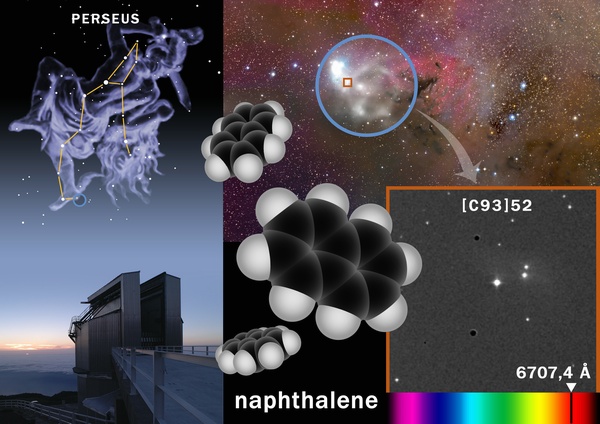Naphthalene molecules, in combination with water, ammonia and ultraviolet radiation, produce many of the amino acids fundamental to the development of life.
A team of scientists led by researchers from the Instituto Astrofísica de Canarias (IAC) has succeeded in identifying naphthalene in a star formation region in the constellation Perseus, in the direction of the star Cernis 52.
This means a large number of the key components in prebiotic terrestrial chemistry could have been present in the interstellar matter from which the Solar System was formed.

IAC researchers Susana Iglesias Groth, Arturo Manchado and Aníbal García, in collaboration with Jonay González (Paris Observatory) and David Lambert (University of Texas) have just published these results in Astrophysical Journal Letters.
“We have detected the presence of the naphthalene cation in a cloud of interstellar matter located 700 light years from the Earth”, says IAC researcher Susana Iglesias Groth. The spectral bands found in this constellation coincide with laboratory measurements of the naphthalene cation.
Iglesias Groth added, “We aim to investigate whether other, more complex, hydrocarbons exist in the same region, including amino acids.” When subjected to ultraviolet radiation and combined with water and ammonium, both very abundant in the interstellar medium, naphthalene reacts and is capable of producing a wide variety of aminoacids and naphthaloquinones, precursor molecules to vitamins.
All these molecules play a fundamental role in the development of life as we know it on Earth.
Naphthalene has been found in meteorites that continue to fall to the surface of the Earth, and which fell with much greater intensity in epochs preceding the appearance of life here.
The work of these researchers could enable an understanding of one of the most intriguing problems in interstellar medium spectroscopy. For the past 80 years, the existence has been known of hundreds of spectroscopic bands (the so-called “diffuse bands”) associated with interstellar matter, but the identification of the agent causing them has remained a mystery.
“Our results show that polycyclic aromatic hydrocarbons such as naphthalene are responsible for the diffuse bands and should be present throughout the interstellar medium”, says Iglesias Groth.
Article: S. Iglesias Groth, A. Manchado, A. García Hernández, Instituto de Astrofísica de Canarias, J. I. González Hernández, Paris Observatory, D. L. Lambert. McDonald Observatory, University of Texas, "Evidence for the naphthalene cation in a region of the interstellar medium with anomalous microwave emission", Astrophysical Journal Letters, 685, L55-L58





Comments